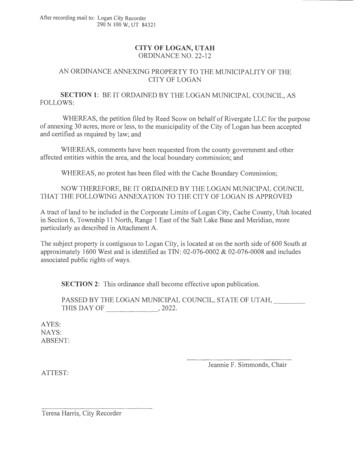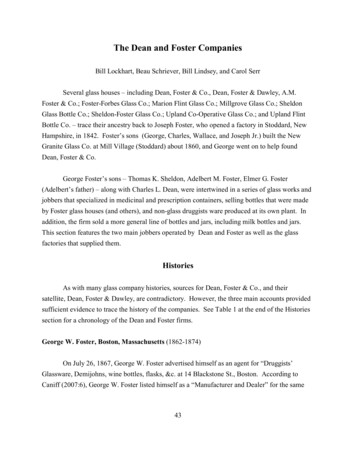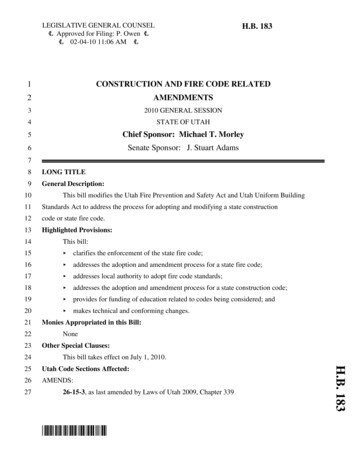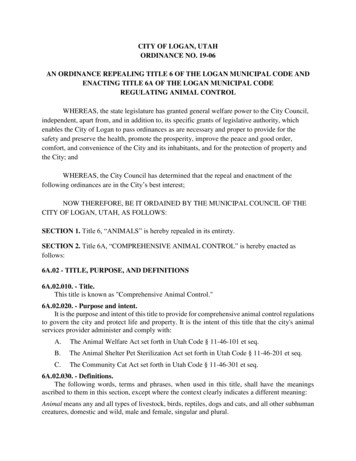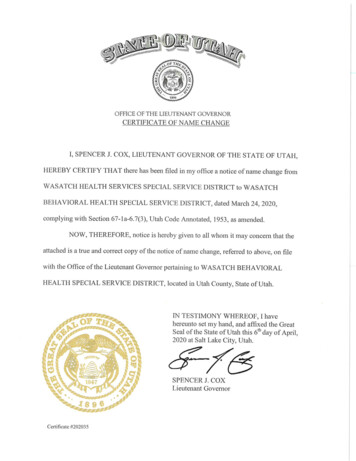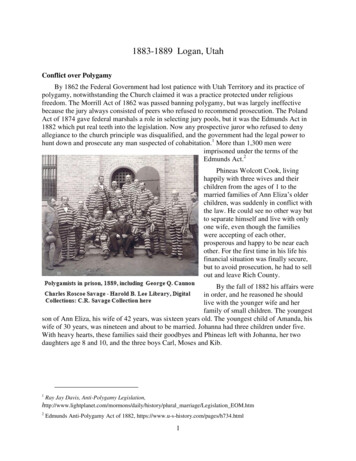
Transcription
1883-1889 Logan, UtahConflict over PolygamyBy 1862 the Federal Government had lost patience with Utah Territory and its practice ofpolygamy, notwithstanding the Church claimed it was a practice protected under religiousfreedom. The Morrill Act of 1862 was passed banning polygamy, but was largely ineffectivebecause the jury always consisted of peers who refused to recommend prosecution. The PolandAct of 1874 gave federal marshals a role in selecting jury pools, but it was the Edmunds Act in1882 which put real teeth into the legislation. Now any prospective juror who refused to denyallegiance to the church principle was disqualified, and the government had the legal power tohunt down and prosecute any man suspected of cohabitation.1 More than 1,300 men wereimprisoned under the terms of theEdmunds Act.2Phineas Wolcott Cook, livinghappily with three wives and theirchildren from the ages of 1 to themarried families of Ann Eliza’s olderchildren, was suddenly in conflict withthe law. He could see no other way butto separate himself and live with onlyone wife, even though the familieswere accepting of each other,prosperous and happy to be near eachother. For the first time in his life hisfinancial situation was finally secure,but to avoid prosecution, he had to sellout and leave Rich County.By the fall of 1882 his affairs werein order, and he reasoned he shouldlive with the younger wife and herfamily of small children. The youngestson of Ann Eliza, his wife of 42 years, was sixteen years old. The youngest child of Amanda, hiswife of 30 years, was nineteen and about to be married. Johanna had three children under five.With heavy hearts, these families said their goodbyes and Phineas left with Johanna, her twodaughters age 8 and 10, and the three boys Carl, Moses and Kib.1Ray Jay Davis, Anti-Polygamy ly/history/plural marriage/Legislation EOM.htm2Edmunds Anti-Polygamy Act of 1882, https://www.u-s-history.com/pages/h734.html1
Probably Fall, 1882 – Sanpete CountyCarl Cook Writings: “I was the oldest of their children, my brother Moses and my brotherKib moved with them to Sanpete County, Utah. It was a new frontier and Father had hopes ofacquiring from the government a farm, probably by ‘Desert Entry.’ I remember practicallynothing of that move, or the stay there, except that later I was told that a mule kicked Father insuch a way that his leg was broken, and while he was confined to bed, or convalescing, someunkind and selfish neighbor ‘jumped’ his land. Which means Father had not fully complied withthe legal requirements, and the other took it from him ”“So he changed his plans and went to Logan instead."3The Desert Land ActFour years before Phineas and Johanna left Swan Creek, the Desert Land Act was passed,encouraging settlement of arid lands in Utah and other western states. Considering Phineas was63 years old and his sons were too young to be of help, claiming homestead land under theDesert Land Entry Act was a huge commitment. Within three years he would have to dig a canalfor irrigation or lose his land. Leaving his investment at Swan Creek for a new start on arid landin Sanpete County must have been a traumatic decision.“The Desert Land Act was passed by the United States Congress on March 3,1877, to encourage and promote the economic development of the arid andsemiarid public lands of the Western states. Through the Act, individuals mayapply for a desert-land entry to irrigate and reclaim the land. This act amended theHomestead Act (1862).” 4“The Desert Land Act became law on March 3, 1877, with the purpose ofencouraging development in the arid and semiarid public lands of the westernstates. Individuals could apply for a “desert land entry” to reclaim, irrigate, andcultivate arid and semiarid public lands. The act offered 640 acres of land to anyadult married couple who paid 1.25 per acre, which was four times the sumallowed by the Homestead Act of 1862, and promised to irrigate the land within athree-year period. A single individual received only 320 acres. The recipient hadto pay twenty-five cents per acre at first and the remaining one dollar per acrewhen the irrigation had been completed.”53Josinette Cook Whiting compiler, The Life Story of Carl and Ella Cook, Salt Lake City, Utah, 1981, p. 12; The laststatement from the Carl cook diary.4"Bureau of Land Management" ml2
Fall of 1882– Move to LoganEva Covey Madsen: “On thelast fifty-two pages of GrandfatherPhineas Wolcott Cook's originaljournal he made copies of manyletters which he wrote and alsocopies of many replies from others.In this "Letter Book," as it wascalled, is a letter which he wrotedated Logan City, March 30, 1883,indicating that sometime shortlybefore that date and after he haddivided his property between hisfamilies, he had moved mygrandmother, Johanna, and heryoung family of three boys, Carl 4years old, Moses 3 years old andKib about six months old, toLogan, Utah. Grandmother'smother, Ulrika Lundgren was withthem, having come from Sweden inSeptember of 1879 whengrandfather sent the money for herpassage“Uncle Carl, the eldest son, tells in his history that they lived in a rented house in Logan atfirst and that while they lived there a doctor came to the house and vaccinated the family againstsmall-pox.”6Small Pox VaccinationA vaccine against the smallpox virus had been in existence for almost one hundred years,but was not well understood. Other states had mandatory vaccination laws, reducing the numberof cases considerably, and Utah health officials were aware that the surrounding states had alower incidence of small pox. Some believed there should be a law requiring a small poxvaccination to protect children from the dreaded disease which left many with heavy scarring andblindness. Death occurred in approximately one-third of the cases of severe infections, and ahigh fever left others with permanent damage.6Eva Covey Madsen , “The Logan Period, 1883 to 1889,” Appendage #3, p. A-17, The Life and History of PhineasWolcott Cook, Second Edition, PWC Family Organization, Brigham City, Utah.3
Some communities launched theirown efforts, namely, Logan. It seemedsuch a simple solution public healthofficials began to urge the passage of alaw. In 1900 Dr. Theodore BruceBeatty was Utah's first health officer,appointed as Utah State HealthCommissioner. He introduced anordinance for compulsory small poxvaccination, but it was opposed bymany in the state, especially in SaltLake City. Newspaper editorslaunched a campaign againstvaccinations. Finally the Utah StateLegislature repealed the ordinance.7Deprived of the simple, provensolution, 15,000 Utahns died ofsmallpox during the next 25 years.8Eva Covey Madsen: “Soonafterward they moved into a lumberhouse, which they always called ‘theshanty ’"Eva Covey Madsen: “ a littlelater grandfather built a concretehouse where they lived until they leftLogan. Their home was located in thelow land south of the Logan Temple and not too far from the mouth of Logan Canyon.”Carl Cook: “Then Father, being attracted to the temple that was then being built in Logan,moved his family there where he obtained a tract of land approximately three or four acres,fenced with a willow fence, adjacent to and west of what is now ‘Crockett Avenue,’ and south of‘Canyon Road.’ Here he built our home, where we lived until it became necessary for us to moveto Wyoming.”97Melvin M. Owens, M.B.A. and Suzanne Dandoy, M.D., M.P.H, “A History of Public Health in Utah,” p. STORY-OF-PUBLIC-HEALTH-IN-UTAH.pdfArdis E. Parshall, The Salt Lake Tribune, “Living History: Even with proven smallpox vaccines, 19th centuryUtahns balked,” http://archive.sltrib.com/article.php?id 53038477&itype CMSID89Josinette Cook Whiting compiler, The Life Story of Carl and Ella Cook, Salt Lake City, Utah, 1981, p. 12.4
The house near Canyon Road atCrockett Avenue is now directly south afew blocks from Utah State University.Old Main and the Quad are now abouttwo blocks north of the old concretehouse which has now been taken down.Being far enough from the city center torequire a very long walk to church, theypetitioned for permission to build anotherhouse of worship in their neighborhood.A copy of the letter in his handwriting isin his letter book, dated “3rd of May1887, 5th Ward Logan City; To thepresiding authorities of the Cache ValleyStake of Zion.” It describes his location:“comonly known as the Logan hollow orriver flume ”Logan TempleEva Covey Madsen: “While thefamily was growing larger down inLogan Hollow, up on top of the hill theLogan Temple was being built. Thecornerstones were laid on September 17,1877 and the Temple was dedicated May17, 1884. So during the years 1883-84A closer look at Canyon Road and Crockett Ave.grandfather used his skill as a builder andcarpenter to help in building the Temple. After theTemple was completed, grandfather andgrandmother worked diligently in the Temple tobring salvation to their ancestors ”Carl Cook: ”Father not only helped to buildthe Logan Temple, he and Mother worked in thetemple for the salvation of the dead, mostly, if notentirely, on Father’s line of genealogy.”10Gothic style of the Logan Temple(Courtesy Cory Maylett)10Josinette Cook Whiting compiler, The Life Story of Carl and Ella Cook, Salt Lake City, Utah, 1981, p. 12.5
On October 6, 1876, thirteen years after theCooks had moved to Bear Lake, a temple in Loganwas announced. To these settlers, a journey of fortymiles compared to 100 miles to the Salt LakeEndowment House was like a small miracle.Designed by Truman O. Madsen with much thesame interior pattern as the Salt Lake Temple, it hada large assembly room, four endowment rooms andsix sealing rooms. However, with gothic details, theLogan Temple looked quite different from the SaltDetails in the original Logan TempleLake Temple. It was built of lime and quartzitebrought from Green Canyon and trees fromLogan Canyon, and labor was donated bythousands of Logan members.Phineas moved to Logan the fall or winterof 1883, and on May 17, 1884 the LoganTemple was dedicated by Church PresidentJohn Taylor. No doubt Phineas was involved infinishing work and woodwork, something atwhich he excelled. His work on the templeprobably accounts for the fact that they renteda cheap house they called “the shanty” whilehe spent his time working on the temple. TheLogan Temple was remodeled in 1977 and theoriginal woodwork was taken out, so nothing remains of his work except his dedicated effort inthe memories of family members.Temple cards showing the name of the person acting as proxy in each ordinance show thatseveral members of the family participatedin temple work during this time. Ann Eliza,Amanda, and several of the adult childrencame from Garden City and attended thetemple to perform ordinances for the dead.As the distance was 40 miles, it would notbe possible for them to return home thesame day they came. There was acontinuous relationship among these familymembers, even though official ties had beensevered. In addition, the family effort tocollect ancestral names was, for that time,amazing. They provided names andordinances for hundreds of ancestors.Original Terrestrial Room, Logan Temple6
PrisonCarl Cook writings: “These were the years when Mormon persecution because of polygamywas reaching a climax, and even though Father was no longer living with either of his first wiveshe was in danger of imprisonment as other men were. At one time he decided he wanted to moveto Canada, but Mother did not approve of it ”“ father in common with many other polygamous men, was hunted and obliged to flee fromhome and to hide where he could. He walked from place to place. Worked a little while where hecould find employment but could not stay long in one place for danger of being arrested by U.S.Marshals and sent to jail. He slept in hay-stacks, in shacks and sheds, and begged food, much asa tramp and finally was taken and sent to prison for a short term—short because of the leniencyof the Judge, and because of father's illness and old age.”11“Mother said that when father was brought into court, to be sentenced, having previouslybeen tried and found guilty of having more than one wife, he looked unusually pale and trembly,and the Judge remarked, ‘Well, Mr. Cook, it appears like you are not going to be long with us.We shall therefore give you a short term and we hope you will never come before this courtagain, on a like charge. You are therefore sentenced to serve thirty days in the Utah StatePenitentiary.’ Father at that time was about 69 years of age.”12Eva Covey Madsen: “Uncle Moses remembers the nightgrandfather got home from jail. He says, ‘The night hereturned home, I remember very well for it was in the wintertime and when he entered the house his beard was all coveredwith frost so thick we could hardly see his face.”13The Church also kept a record of men imprisoned forpolygamy, and Phineas Wolcott Cook appears in the JournalHistory of the Church after his arrest in 1888.14 Although itwas a difficult time for the saints, by this time in churchhistory they did not doubt the inspiration behind the revelationto have more than one wife. Hundreds of women who neverwould have married had there been monogamy had beenblessed to have families and enrich the population of the11Josinette Cook Whiting compiler, The Life Story of Carl and Ella Cook, Salt Lake City, Utah, 1981, pp. 13-14.Also recorded in Carl Cook Diary, p. 30.12Eva Covey Madsen , “The Logan Period, 1883 to 1889, Appendage #3, p. A-21, The Life and History of PhineasWolcott Cook, Second Edition, PWC Family Organization, Brigham City, Utah.13Moses Cook diary. Also recorded in Eva Covey Madsen , “The Logan Period, 1883 to 1889, Appendage #3, p. A22, The Life and History of Phineas Wolcott Cook, Second Edition, PWC Family Organization, Brigham City,Utah.14Journal History to the Church of Jesus Christ of Latter-day Saints. FHL Index film, C- 1,233,511, 1888: Dec. 1 p.4.7
territory. Local legislators were arguing to have Utah admitted into the Union of States on itsown terms, while Washington theorists hastened to consider restrictions based on laws hostile topolygamy and religious freedom.15The Church was prepared to suffer whatever was necessary. In 1887 the Edmunds-TuckerAct was passed, and the church faced confiscation of its property and the revocation of itscorporate charter. Much prayer and fasting resulted in the revelation which changed the church’spolicy. The only thing left was for men with more than one wife to either divorce their pluralwives or flee the state. It was in 1888, after that act was passed, that Phineas Wolcott Cook wasarrested and imprisoned.Ham’s Fork, WyomingEva Covey Madsen citing Moses Cook: “Grandfather decided to move to Ham’s Fork inUintah County, Wyoming, farther out on the frontier where there was less chance of interferenceby government officials. Early in the summer of 1889, grandfather wrote his son Hyrum, AnnEliza’s son, and asked him to come to Logan with team and wagon and help move the family toHam’s Fork where there was open land and where he could raise his boys and teach them howto work.“ All the country was wild and open, no fences except occasionally a large round polecorrall where cowboys separated and branded cattle. There were hundreds of cattle all aroundthem and among them were many large bulls which frightened grandmother for their safety,especially for the children. Neighbors were very few and miles apart ”16Phineas came home from his prison term with a determination to leave the state. Five yearsearlier two of his sons, Joseph W. and William, had moved to Border, Wyoming, just north and15Sarah Barringer Gordon, 'The Mormon Question: Polygamy and Constitutional Conflict in Nineteenth-CenturyAmerica,' pp. 9-10, 109-111.16Eva Covey Madsen , “The Logan Period, 1883 to 1889, Appendage #3, p. A-22, The Life and History of PhineasWolcott Cook, Second Edition, PWC Family Organization, Brigham City, Utah.8
east of the north tip of Bear Lake. Their brothers Alonzo, David and Henry H. had joined themwith a proposal for a dam over the Bear River and a four-mile ditch project at Border, callingthemselves the Cook Brothers Company.17 Phineas decided he could make a living by starting adairy farm, and may have thought of going to Border, but it was too close to Utah and he decidedto move farther east, somewhere along the Ham’s Fork of the Black River, which eventually runsinto the Green River. The river runs from Kemmerer to join the Black Fork just south of thepresent I-80, still with few settlers along its course. Not far from Little America on I-80, theOregon/Mormon Trail crosses the highway and moves westward. There was a sparse settlementalong the Ham’s Fork of the Black River, a few miles north, and the Cooks went somewherenear there.Ranchers had already moved large herds of cattle into the area. Horace Greeley wrote in1859 that these cattlemen had set up a thriving business:“On these streams live several old mountaineers, who have large herds ofcattle which they are rapidly increasing by lucrative traffic with the emigrants,who are compelled to exchange their tired, gaunt oxen and steers for fresh ones onalmost any terms.”18With his own herd of about thirty dairy cattle, Phineas hoped he could legally stake a claimfor his own dairy ranch. But this was wild country, and the Cook family was isolated from everyvestige of civilization. After living there a few months of the summer, he realized he would haveno help whatever if anything happened. His neighbors told him it would be impossible to staythrough the winter. His wife was expecting a baby soon, and at 69 years of age he recognized hisneed to live in an organized town. Thankfully Idalia Johanna, their last child, was born onSeptember 4, 1889 after they had returned to Logan.But once again, Phineas was not safe from arrest. In Swan Creek he had been very close tohis daughter Phebe and her husband Byron H. Allred, who was also a polygamist. Byron found itnecessary to find another place to live, and in the spring of 1889 he took his families to Afton,Wyoming. They recognized immediately it would be a good situation. A few other men Phineasknew also went to Afton. State officials were unwilling to prosecute men for polygamy becausethe Territory of Wyoming was trying to increase their population so they could be admitted intothe Union. Federal marshals, anxious to continue the hunt taking place in Utah, were turnedaway.The stage was set for Phineas W. Cook to take his young family to Wyoming where hewould be safe among friends. Six weeks after Idalia was born they left Logan and headed forAfton. Before leaving he sold his house in Logan for 1,000, bought a new wagon and a boremachine for making a leaning fence. His plan was to go into the dairy farming business.1917Uinta County, Wyoming, Mixed Records, FHL 973,813, affidavit 29791, Book 28, pp. 67-68 and FHL 973,814,item 2, pp. 2, 442-444.) Joseph W. and William Cook of Border, Wyoming, and Alonzo, David S. and Henry H.Cook of Garden City signed the affidavit.18Greeley, Horace. An Overland Journey, from New York to San Francisco in the Summer of 1859. Charles T.Duncan, ed. New York, N.Y: Alfred A. Knopf, 1964.19Eva Covey Madsen , “The Logan Period, 1883 to 1889, Appendages #3, p. A-23 and #4, p; A-26. The Life andHistory of Phineas Wolcott Cook, Second Edition, PWC Family Organization, Brigham City, Utah.9
1883-1889 Logan, Utah Conflict over Polygamy By 1862 the Federal Government had lost patience with Utah Territory and its practice of polygamy, notwithstanding the Church claimed it was a practice protected under religious freedom. The Morrill Act of 1862 was passed banning polygamy, but was largely ineffective
